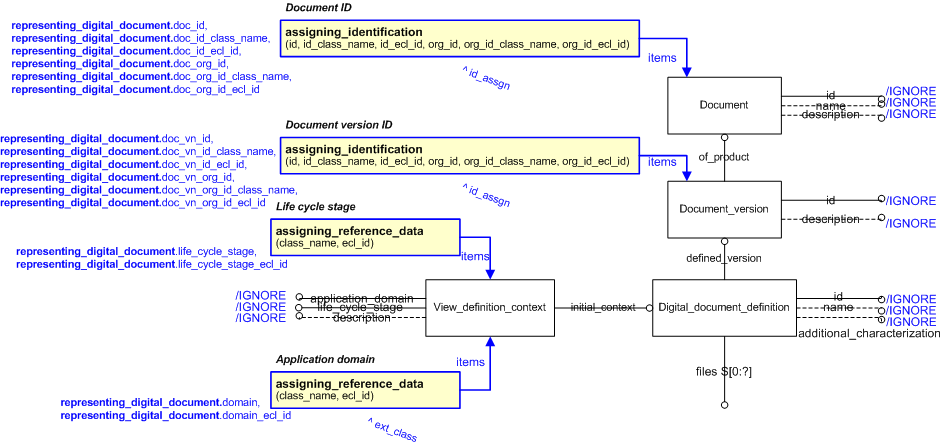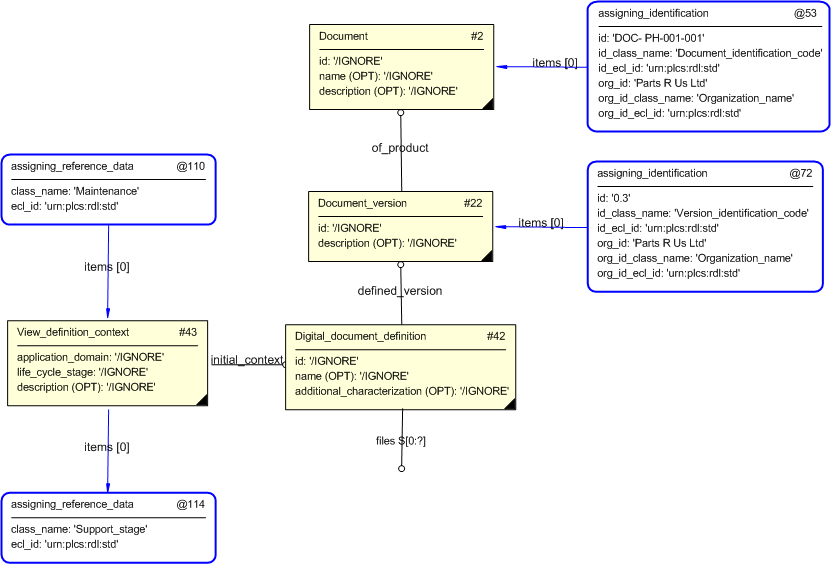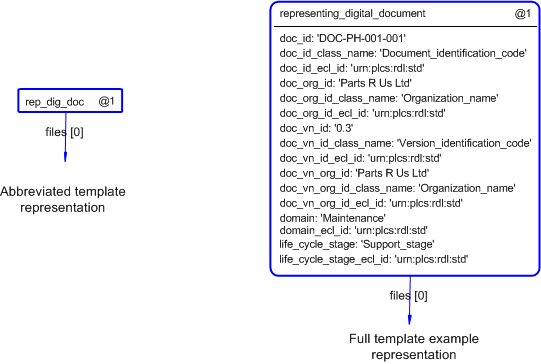Template:— representing_digital_document (rep_dig_doc)
Capability:representing_documents |
Date: 2009/03/18 11:45:33
Revision: 1.6
|
This section specifies the template representing_digital_document.
NOTE
The template has been defined in the context of the capability
representing_documents
which provides an overall description of the
relevant parts of the ISO 10303-239 information model and a description
of related templates.
NOTE
An explanation of a template and the associated instantiation path is
provided in the
Template overview
section.
This template describes how to represent a digital document.
The EXPRESS-G diagram in
Figure
1
shows the templates and EXPRESS entities that are required
to represent the template
"representing_digital_document".
The text highlighted in blue shows the template parameters.
Figure 1 — An EXPRESS-G representation of the Information model for representing_digital_document
The graphic for the template to be used in other EXPRESS-G diagrams
is shown in Figure
2
below.
Figure 2 — The graphical representation of the representing_digital_document template
The following input parameters are defined for this template:
The identifier of the document
The following classes and their sub-classes can be used:
The location of the
External_class_library
that stores the classifications used to classify the document, document_version and document_definition.
The name or identifier of the organization responsible for the document representation
The name of the class being used to classify the identification (
Identification_assignment)
of the organization responsible for creating the document representation
The following classes and their sub-classes can be used:
The identifier of the
External_class_library storing the
definition of the class used to classify the organization identifier.
The version identifier of the document version
The following classes and their sub-classes can be used:
The location of the
External_class_library
that stores the classifications used to classify the document, document_version and document_definition.
The name or identifier of the organization responsible for the document representation
The name of the class being used to classify the identification (
Identification_assignment)
of the organization responsible for the document representation
The following classes and their sub-classes can be used:
The identifier of the
External_class_library storing the
definition of the class used to classify the organization identifier.
domain (Default=Product_life_cycle_support,Type='CLASS', Optional)
The id of the
External_class_library
used to describe the type of application domain of the view_definition_context instance.
The following classes and their sub-classes can be used:
The identifier of the
External_class_library storing the
definition of the class used to classify the organization identifier.
The id of the
External_class_library
used to describe the type of life cycle stage of the view_definition_context instance.
The following classes and their sub-classes can be used:
The identifier of the
External_class_library storing the
definition of the class used to classify the organization identifier.
The entities to which the Digital_document_definition may be related to.
The following reference parameters are defined for this template:
Allow the
Document
entity instantiated in this path to be referenced when this template is used.
Note: The
Document
entity can be referenced in a template path by:
%^target = $representing_digital_document.document%
where
target
is the parameter to which the
Document
is bound.
Allow the
Document_version
entity instantiated in this path to be referenced when this template is used.
%^target = $representing_digital_document.document_version%
%^target = $representing_digital_document.digital_document_definition%
%^target = $representing_digital_document.view_definition_context%
The instantiation path shown below specifies the entities that are to be
instantiated by the template.
A description of templates and the syntax for the instantiation path is
provided in the
Templates Help/Information section.
Document-- Mark the Document entity as -- referable when this template is used by binding it to the reference -- parameter id_assgn %^document =
Document%
Document.id = '/IGNORE'
Document.name = '/IGNORE'
Document.description = '/IGNORE'
-- Identify the Document /
assigning_identification(
items=^document,
id=@doc_id,
id_class_name=@doc_id_class_name,
id_ecl_id=@doc_id_ecl_id,
org_id=@doc_org_id,
org_id_class_name=@doc_org_id_class_name,
org_id_ecl_id=@doc_org_id_ecl_id )/
Document_version-- Mark the Document_version entity as -- referable when this template is used by binding it to the reference -- parameter ^document_version %^document_version =
Document_version%
Document_version.id = '/IGNORE'
Document_version.description = '/IGNORE'
-- Relate the document_version to the document Document_version.of_product ->
Document-- Identify the Document_version /
assigning_identification(
items=^document_version,
id=@doc_vn_id,
id_class_name=@doc_vn_id_class_name,
id_ecl_id=@doc_vn_id_ecl_id,
org_id=@doc_vn_org_id,
org_id_class_name=@doc_vn_org_id_class_name,
org_id_ecl_id=@doc_vn_org_id_ecl_id )/
Digital_document_definition-- Mark the Digital_document_definition entity as -- referable when this template is used by binding it to the reference -- parameter ^digital_document_definition %^digital_document_definition =
Digital_document_definition%
Digital_document_definition.id = '/IGNORE'
Digital_document_definition.name = '/IGNORE'
Digital_document_definition.additional_characterization = '/IGNORE'
-- If an optional Digital hardcopy is provided, then link it to the Digital doc definition Digital_document_definition.files ->
@digital_file-- Relate the document_version to the document Digital_document_definition.defined_version ->
Document_versionView_definition_context-- Mark the View_definition_context entity as -- referable when this template is used by binding it to the reference -- parameter ^view_definition_context %^view_definition_context =
View_definition_context%
-- Ignore the attributes View_definition_context.application_domain = '/IGNORE'
View_definition_context.life_cycle_stage = '/IGNORE'
View_definition_context.description = '/IGNORE'
-- provide the application domain of the view definition by classification /
assigning_reference_data(
items=^view_definition_context,
class_name=@life_cycle_stage,
ecl_id=@life_cycle_stage_ecl_id)/
-- provide the life cycle stage of the view definition by classification /
assigning_reference_data(
items=^view_definition_context,
class_name=@domain,
ecl_id=@domain_ecl_id)/
-- Relate the digital_document_definition to the View_definition_context Digital_document_definition.initial_context ->
View_definition_context
The following entities are instantiated with attributes as specified:
The instance diagram in Figure
3
shows an example of the EXPRESS entities and templates that are instantiated by the template:
/representing_digital_document(doc_id='DOC-PH-001-001', doc_id_class_name='Document_identification_code', doc_id_ecl_id='urn:plcs:rdl:std', doc_org_id='Parts R Us Ltd', doc_org_id_class_name='Organization_name', doc_org_id_ecl_id='urn:plcs:rdl:std', doc_vn_id='0.3', doc_vn_id_class_name='Version_identification_code', doc_vn_id_ecl_id='urn:plcs:rdl:std', doc_vn_org_id='urn:plcs:rdl:std', doc_vn_org_id_class_name='Organization_name', doc_vn_org_id_ecl_id='urn:plcs:rdl:std', domain='Maintenance', domain_ecl_id='urn:plcs:rdl:std', life_cycle_stage='Support_stage', life_cycle_stage_ecl_id='urn:plcs:rdl:std')/
(an illustration of the consolidated representing_digital_document template is shown in
Figure
4 below.)
Figure 3 — Entities instantiated by representing_digital_document template
The instance model in STEP ASCII exchange file format (ISO 10303 Part
21 syntax) is:
DATA;
#15 = EXTERNAL_CLASS('/IGNORE','Organization_name','/IGNORE',#16);
#14 = CLASSIFICATION_ASSIGNMENT(#15,(#12),'/IGNORE');
#12 = IDENTIFICATION_ASSIGNMENT('Parts R Us Ltd','/IGNORE','/IGNORE',(#10));
#10 = ORGANIZATION('/IGNORE','/IGNORE');
#8 = EXTERNAL_CLASS_LIBRARY('urn:plcs:rdl:std',$);
#7 = EXTERNAL_CLASS('/IGNORE','Document_identification_code','/IGNORE',#8);
#6 = CLASSIFICATION_ASSIGNMENT(#7,(#4),'/IGNORE');
#4 = IDENTIFICATION_ASSIGNMENT('DOC-PH-001-001','/IGNORE',$,(#2));
#2 = DOCUMENT('/IGNORE','/IGNORE','/IGNORE');
#30 = ORGANIZATION('/IGNORE','/IGNORE');
#28 = EXTERNAL_CLASS_LIBRARY('urn:plcs:rdl:std',$);
#27 = EXTERNAL_CLASS('/IGNORE','Version_identification_code','/IGNORE',#28);
#26 = CLASSIFICATION_ASSIGNMENT(#27,(#24),'/IGNORE');
#24 = IDENTIFICATION_ASSIGNMENT('0.3','/IGNORE',$,(#22));
#22 = DOCUMENT_VERSION('/IGNORE','/IGNORE',#2);
#21 = EXTERNAL_CLASS_LIBRARY('urn:plcs:rdl:std',$);
#20 = EXTERNAL_CLASS('/IGNORE','Owner_of','/IGNORE',#21);
#19 = CLASSIFICATION_ASSIGNMENT(#20,(#17),'/IGNORE');
#17 = ORGANIZATION_OR_PERSON_IN_ORGANIZATION_ASSIGNMENT(#10,'/IGNORE',(#4));
#16 = EXTERNAL_CLASS_LIBRARY('urn:plcs:rdl:std',$);
#47 = EXTERNAL_CLASS_LIBRARY($,$);
#46 = EXTERNAL_CLASS('/IGNORE','Support_stage','/IGNORE',#47);
#45 = CLASSIFICATION_ASSIGNMENT(#46,(#43),'/IGNORE');
#43 = VIEW_DEFINITION_CONTEXT('/IGNORE','/IGNORE','/IGNORE');
#42 = DIGITAL_DOCUMENT_DEFINITION('/IGNORE','/IGNORE','/IGNORE',#43,(),#22,());
#41 = EXTERNAL_CLASS_LIBRARY('urn:plcs:rdl:std',$);
#40 = EXTERNAL_CLASS('/IGNORE','Owner_of','/IGNORE',#41);
#39 = CLASSIFICATION_ASSIGNMENT(#40,(#37),'/IGNORE');
#37 = ORGANIZATION_OR_PERSON_IN_ORGANIZATION_ASSIGNMENT(#30,'/IGNORE',(#24));
#36 = EXTERNAL_CLASS_LIBRARY('urn:plcs:rdl:std',$);
#35 = EXTERNAL_CLASS('/IGNORE','Organization_name','/IGNORE',#36);
#34 = CLASSIFICATION_ASSIGNMENT(#35,(#32),'/IGNORE');
#32 = IDENTIFICATION_ASSIGNMENT('Parts R Us Ltd','/IGNORE','/IGNORE',(#30));
#51 = EXTERNAL_CLASS_LIBRARY('urn:plcs:rdl:std',$);
#50 = EXTERNAL_CLASS('/IGNORE','Maintenance','/IGNORE',#51);
#49 = CLASSIFICATION_ASSIGNMENT(#50,(#43),'/IGNORE');
ENDSEC;
The instance model in STEP XML exchange file format (ISO 10303 Part
28 ed.2 syntax) is:
The instance diagram in
Figure
4
shows the graphic symbol for the template that is to be
used in other instance diagrams. The example template is:
/representing_digital_document(doc_id='DOC-PH-001-001', doc_id_class_name='Document_identification_code', doc_id_ecl_id='urn:plcs:rdl:std', doc_org_id='Parts R Us Ltd', doc_org_id_class_name='Organization_name', doc_org_id_ecl_id='urn:plcs:rdl:std', doc_vn_id='0.3', doc_vn_id_class_name='Version_identification_code', doc_vn_id_ecl_id='urn:plcs:rdl:std', doc_vn_org_id='urn:plcs:rdl:std', doc_vn_org_id_class_name='Organization_name', doc_vn_org_id_ecl_id='urn:plcs:rdl:std', domain='Maintenance', domain_ecl_id='urn:plcs:rdl:std', life_cycle_stage='Support_stage', life_cycle_stage_ecl_id='urn:plcs:rdl:std')/
Figure 4 — Entities instantiated by representing_digital_document template
The following section details how the
representing_digital_document
template can be optionally characterized by assigning
other constructs to it. These are characterizations commonly
applied to the template. The ISO 10303-239 EXPRESS model may enable
other assignments to the entities instantiated by the template.
The following characterizations may apply:
Characterization Assigning date
NOTE this characterization is optional.




